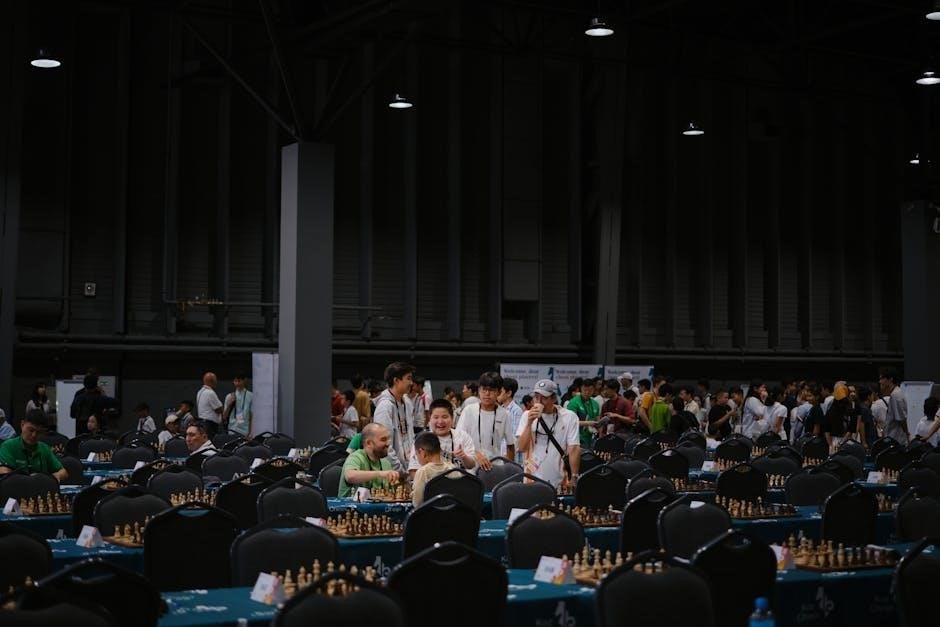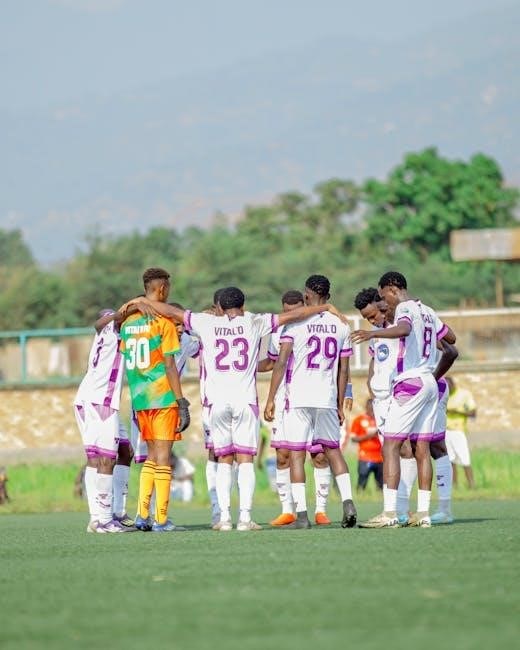PIP Decks are strategic card decks used in team play, emphasizing collaboration and pre-planned tactics. They enhance gameplay through synergy, communication, and adaptive strategies, fostering competitive success.
1.1 What Are PIP Decks?
PIP Decks are specialized card decks designed for team-based strategies, emphasizing pre-planned tactics and collaborative gameplay. They enhance performance through strategic planning, coordination, and adaptability, making them essential for competitive play. PIP Decks allow teams to anticipate opponents’ moves and adjust strategies effectively. They foster a structured approach, maximizing each member’s strengths for cohesive efforts. Their design balances offensive and defensive elements, ensuring versatility in various competitive formats, and are widely recognized for their role in elevating team dynamics and strategic execution in card-based games.
1.2 Importance of Team Tactics in PIP Decks
Team tactics are crucial in PIP Decks as they enhance coordination, communication, and strategic execution. By aligning team members’ actions, players can anticipate opponents’ moves and adapt strategies effectively. Team tactics foster a structured approach, ensuring each member’s strengths are utilized optimally. They also promote collaborative decision-making, reducing errors and improving overall performance. In competitive play, well-executed team tactics can turn the tide of a game, making them indispensable for achieving success. They are essential for balancing offensive and defensive playstyles, ensuring versatility and adaptability in dynamic gameplay scenarios.
1.3 Overview of the PIP Decks Team Tactics PDF
The PIP Decks Team Tactics PDF serves as a comprehensive guide to mastering collaborative strategies in competitive play. It covers core principles, advanced techniques, and real-world applications, offering insights into deck optimization and team synergy. The guide emphasizes pre-game planning, communication, and adaptability, providing players with actionable strategies to enhance their gameplay. By focusing on both offensive and defensive approaches, it equips teams with the tools to outmaneuver opponents. The PDF also includes expert opinions and case studies, making it an invaluable resource for aspiring and seasoned players aiming to elevate their team’s performance and achieve victory.

Core Strategies in PIP Decks Team Tactics
Core strategies in PIP Decks involve offensive, defensive, and adaptive tactics, emphasizing teamwork, synergy, and quick decision-making to outmaneuver opponents while maintaining flexibility in gameplay.
2.1 Offensive Strategies
Offensive strategies in PIP Decks focus on aggressive playstyles, utilizing high-impact cards to dominate early game phases. These tactics emphasize quick, decisive moves to pressure opponents, creating openings for further attacks. Effective communication among team members is crucial to coordinate card plays and execute combo decks seamlessly. Offensive strategies also involve adapting to the opponent’s moves, ensuring that each play maximizes damage output while maintaining control over the game’s tempo. By leveraging synergy between cards and team members, offensive strategies aim to overwhelm opponents, securing victory through relentless pressure and strategic card utilization.
2.2 Defensive Strategies
Defensive strategies in PIP Decks focus on stabilizing the game, countering opponents’ moves, and protecting key assets. These tactics involve using control cards to disrupt opponents’ plans, maintaining board control, and minimizing damage. Effective defensive play requires anticipation of opponents’ moves, leveraging card synergies, and coordinating with teammates. Defensive strategies also include adaptive measures, such as switching to a more conservative approach during high-pressure situations. By balancing defense with offensive potential, teams can create a resilient gameplay foundation, ensuring longevity in competitive matches and maintaining strategic flexibility.
2.3 Synergy Between Team Members
Synergy between team members is crucial for effective gameplay in PIP Decks. By understanding each other’s strengths and roles, teams can execute strategies seamlessly. Clear communication ensures coordination, allowing players to anticipate and support each other’s moves. Synergy enhances overall performance, enabling complex plays and maximizing card potential. It fosters trust and adaptability, essential for countering opponents’ tactics. Strong team synergy transforms individual efforts into a cohesive unit, elevating gameplay and increasing chances of success in competitive matches.
2.4 Adapting to Opponent’s Moves
Adapting to opponents’ moves is vital for maintaining control in PIP Decks. Teams must stay flexible, adjusting strategies based on the opponent’s playstyle. This involves identifying key cards and patterns early, allowing for timely countermeasures. Effective communication ensures quick decision-making, enabling teams to pivot seamlessly. Anticipating opponents’ moves and preparing responses enhances overall adaptability. By staying proactive and responsive, teams can disrupt opponents’ plans and maintain a strategic advantage throughout the game.
Advanced Tactics for Competitive Play
Advanced tactics in competitive play involve dynamic strategies and high-stakes execution. Combo decks, control strategies, and synergy drive success in competitive PIP Decks environments.
3.1 Combo Decks and Their Execution
Combo decks in PIP Decks rely on precise card synergies to deliver powerful, game-changing plays. Execution demands meticulous planning, timing, and coordination among team members to maximize impact and outmaneuver opponents. These decks often combine low-cost, high-value cards to create overwhelming board presence. Success hinges on anticipating opponent moves and adapting strategies mid-game. Effective communication is crucial to synchronize plays and ensure all team members are aligned. Combo decks are high-risk, high-reward, requiring practice and teamwork to execute flawlessly in competitive settings.
3.2 Control Decks and Their Impact
Control decks in PIP Decks focus on disrupting opponents’ strategies while maintaining board control. They rely on removal spells, counterspells, and card draw to neutralize threats and stabilize the game. These decks often include key cards like board wipes and counterspells to reset the opponent’s momentum. Control decks are crucial in competitive play, as they allow teams to dictate the game’s pace and create opportunities for late-game dominance. Effective execution requires precise timing and teamwork to maximize their impact and secure victories in high-stakes scenarios.
3.3 Aggro Decks and Early Game Dominance
Aggro decks in PIP Decks prioritize early-game aggression, aiming to overwhelm opponents quickly. These decks feature low-cost, high-impact creatures and spells that accelerate damage output. By leveraging explosive starts, aggro decks pressure opponents from the first turns, forcing them into defensive positions. Effective use of mana curves and synergistic plays ensures rapid board development. Aggro strategies thrive in competitive environments, where early dominance can dictate game outcomes. Teams employing aggro decks must balance aggression with situational adaptability to maintain momentum and secure victories before opponents can stabilize.
3.4 Midrange Decks and Versatility
Midrange decks in PIP Decks excel through balanced strategies, blending early-game aggression with late-game sustainability. These decks often feature versatile creatures and spells, allowing adaptation to various playstyles. By incorporating mid-cost cards with high value, midrange decks aim to outlast aggressive starts while countering control strategies. Their flexibility makes them resilient in competitive environments, as they can pivot between offense and defense. Key to success is maintaining consistent pressure and leveraging card synergy. Midrange decks are ideal for teams seeking a balanced approach, capable of addressing multiple threats without sacrificing early-game impact or late-game staying power.

Team Collaboration and Communication
Team collaboration and communication are vital for synchronized play, ensuring each member’s role aligns with strategic goals. Clear communication enhances adaptability and trust, driving success.
4.1 Role of Each Team Member
Understanding each team member’s role is crucial for effective teamwork. Leaders set strategies, while players execute them. Communication ensures alignment, fostering a cohesive unit. Roles adapt to strengths, optimizing performance. Clear responsibilities prevent overlaps, enhancing efficiency. Synergy emerges when roles align, driving success. Adaptability to roles maintains flexibility. Collaboration flourishes when roles are respected, promoting trust.
4.2 Effective Communication During Matches
Effective communication is vital during matches to ensure seamless teamwork. Clear and concise messaging helps avoid misunderstandings, enabling quick decision-making. Team members must actively listen and provide feedback, fostering alignment. Using agreed-upon signals or codes enhances coordination. Maintaining composure under pressure prevents miscommunication. Regular check-ins ensure everyone stays informed. Adapting communication strategies based on the game’s flow keeps the team responsive. Open dialogue post-match aids in identifying strengths and areas for improvement, fostering growth. Strong communication builds trust, enhancing overall performance and teamwork dynamics in high-stakes environments.
4.3 Pre-Game Planning and Strategy
Pre-game planning is essential for aligning team goals and strategies. Assign roles based on strengths and deck compositions, ensuring each member understands their responsibilities. Analyze opponents’ potential moves and adapt your tactics accordingly. Discuss key cards, synergies, and signals to maintain coordination. Review past matches to identify patterns and improve decision-making. Establish a clear communication plan to avoid confusion during gameplay. Mental preparation and team alignment are crucial for maintaining focus and adaptability. A well-structured pre-game strategy fosters confidence and cohesion, setting the team up for success in competitive play.
4.4 Post-Game Analysis and Improvement
Post-game analysis is crucial for identifying strengths and areas for improvement. Review gameplay to assess strategy execution, communication, and decision-making. Discuss what worked well and what didn’t, focusing on key moments that influenced the outcome. Use feedback to refine deck compositions and teamwork. Analyze opponents’ strategies to anticipate future moves. Document lessons learned and implement adjustments in future matches. Continuous improvement fosters growth and enhances team cohesion, ensuring long-term success in competitive play.

Deck Building and Optimization
Deck building and optimization are essential for competitive success, focusing on card synergy, balance, and adaptability. Refining decks enhances performance and aligns with team strategies.
5.1 Key Cards for Team Synergy
Key cards are essential for enabling team synergy, enhancing collaborative gameplay. They include cards that provide card draw, board control, or protection, ensuring seamless coordination. Properly integrating these cards strengthens overall strategy, fostering a cohesive team effort. Identifying and prioritizing such cards is crucial for optimizing deck performance. They act as the backbone of synchronized plays, allowing teams to execute complex maneuvers effectively. Balancing these cards ensures versatility while maintaining a competitive edge, making them indispensable in advanced deck-building strategies.
5.2 Balancing Deck Archetypes
Balancing deck archetypes is crucial for maintaining versatility and adaptability in PIP Decks. Each archetype, such as Aggro, Control, or Midrange, serves distinct roles, ensuring a well-rounded strategy. Aggro decks excel at early aggression, while Control decks focus on disruption and stability. Midrange decks offer a balance, adapting to various scenarios. Synergy between these archetypes enhances team performance, allowing for dynamic shifts in gameplay. Strategic card selection and mana curve optimization are key to balancing these styles, ensuring each archetype complements the others while addressing opponents’ strengths and weaknesses effectively.
5.3 Incorporating New Cards and Strategies
Incorporating new cards and strategies into PIP Decks requires careful consideration of synergy and balance. Introducing fresh cards can enhance deck performance, but it’s essential to playtest their impact on existing strategies. Teams should assess how new cards align with their overall game plan and adapt tactics accordingly. Regular updates ensure the deck remains competitive, while strategic adjustments prevent opponents from anticipating moves. By staying informed about meta trends and experimenting with innovative card combinations, teams can maintain a dynamic and formidable deck. Continuous refinement is key to staying ahead in competitive play.
5.4 Avoiding Common Deck Building Mistakes
Avoiding common deck building mistakes ensures optimal performance. Overloading decks with too many strategies can reduce focus, while neglecting synergy often leads to inefficiency. Relying too heavily on a single card or tactic can make decks predictable. Additionally, ignoring the meta or opponent trends risks outdated strategies. Conducting regular inventory of cards and playtesting new additions helps identify weaknesses. Balancing innovation with proven tactics prevents costly oversights. By addressing these pitfalls, players can craft decks that are both competitive and adaptable, ensuring long-term success in PIP Decks team play.

Psychological Aspects of Team Play
Team play in PIP Decks demands mental resilience, strategic pressure handling, and adaptive mind games to outmaneuver opponents while maintaining collaborative synergy and focus under stress.
6.1 Mind Games and Opponent Manipulation
Mind games in PIP Decks involve psychological tactics to manipulate opponents’ decisions, creating strategic advantages; Techniques include bluffing, baiting, and maintaining a poker face to disguise intentions. Players can use silence or selective communication to mislead, fostering uncertainty. Baiting opponents with seemingly weak plays can provoke overconfidence, leading to critical mistakes. Reading opponents’ patterns and adapting strategies accordingly enhances control over the game flow. Mastering these psychological tactics requires sharp intuition and emotional discipline, turning mental pressure into a powerful tool for competitive dominance.
6.2 Maintaining Team Morale
Maintaining team morale is crucial for long-term success in PIP Decks. A positive environment fosters collaboration and resilience, especially during losses. Recognizing individual contributions and celebrating small victories boosts confidence. Encouraging open communication helps resolve conflicts and strengthens trust. Setting realistic goals and acknowledging progress keeps the team motivated. Constructive feedback, rather than criticism, promotes growth. Leading by example and demonstrating adaptability inspires unity. A cohesive, motivated team is better equipped to handle pressure and adapt to challenges, ensuring sustained performance in competitive play.
6.3 Handling Pressure and High-Stakes Situations
Handling pressure and high-stakes situations is essential for success in PIP Decks. Teams must remain composed under stress to execute strategies effectively. Techniques like deep breathing and mental exercises can help maintain focus. Learning from past high-pressure scenarios allows teams to refine their approaches. Effective communication and a positive attitude are crucial in keeping the team resilient. By staying calm and adhering to the game plan, teams can overcome even the most intense challenges. Experience and preparation are key to managing pressure and securing victories in competitive play.
6.4 Reading Opponent’s Moves and Patterns
Reading opponents’ moves and patterns is a cornerstone of competitive PIP Decks play. Teams must analyze their opponents’ card choices, playstyle, and deck archetype to anticipate strategies. Observing recurring patterns in their moves can reveal weaknesses to exploit. Understanding their inventory and potential synergies allows for better counterplay. Adapting tactics mid-game based on these insights ensures a dynamic approach. Effective pattern recognition enhances decision-making and increases the likelihood of outmaneuvering opponents. Mastering this skill is crucial for staying ahead in high-stakes matches and securing victories.

Case Studies and Real-World Applications
Case studies highlight successful team tactics in past matches, offering insights into effective strategies and adaptability. Real-world applications demonstrate how these tactics evolve and apply to diverse playstyles historically.
7.1 Successful Team Tactics in Past Matches
Historical matches reveal key strategies that led to victory, such as coordinated offensive plays and defensive synergies. Teams often utilized combo decks to overwhelm opponents, while control decks maintained board dominance. Successful tactics included precise timing of high-impact cards and adaptive mid-game shifts. These strategies highlight the importance of pre-game planning and in-match communication. By analyzing past successes, players can replicate effective methods, ensuring competitive dominance. These case studies serve as blueprints for modern teams, emphasizing the value of historical insights in refining current tactics and securing future wins.
7.2 Lessons Learned from Failed Strategies
Analyzing failed strategies in PIP Decks reveals critical lessons. Common pitfalls include poor communication, overcommitting to specific tactics, and failure to adapt mid-game. Teams often underestimate the importance of flexibility, leading to losses when strategies become predictable; For instance, relying too heavily on combo decks without contingency plans can backfire. Additionally, neglecting to adjust to the opponent’s tactics or meta shifts often results in defeat. These failures highlight the need for post-game analysis to identify mistakes and refine approaches. Learning from these errors is essential for improving teamwork and strategic execution in future matches.
7.3 Adapting Tactics to Different Playstyles
Adapting tactics to different playstyles is crucial for success in PIP Decks. Teams must identify opponents’ strategies early, whether they favor aggressive, defensive, or combo-focused approaches. For example, countering an aggressive deck requires robust early-game defenses and quick transitions. Conversely, against control decks, patience and selective card usage are key. Flexibility in unit deployment and card synergy ensures effectiveness. Lessons from past failures highlight the importance of tailoring strategies to opponents’ strengths. Continuous learning and adaptability are vital for staying competitive in dynamic matchups, ensuring teams remain unpredictable and resilient against diverse playstyles. This approach fosters long-term success in PIP Deck competitions.
7.4 Historical Evolution of Team Tactics in PIP Decks
The historical evolution of team tactics in PIP Decks reflects a journey from basic strategies to sophisticated, meta-driven approaches. Early play focused on individual card strength, while modern tactics emphasize synergy and coordination. Key turning points include the rise of combo decks, the development of control strategies, and the integration of new card mechanics. The competitive scene has driven innovation, with teams adapting to balance changes and emerging playstyles. This progression highlights how PIP Decks have become a dynamic, community-shaped phenomenon, continually evolving to challenge players and reward creativity. Historical analysis reveals a game deeply influenced by its dedicated player base.
Expert Insights and Interviews
Top players and coaches share strategies, meta trends, and tips for mastering PIP Decks. Their insights reveal how to adapt and excel in competitive team play environments.
8.1 Interviews with Top Players and Coaches
Interviews with top players and coaches reveal expert strategies and insights into PIP Decks. They discuss meta trends, deck optimization, and teamwork essentials. Coaches emphasize adaptability and communication, while players share personal anecdotes and tips for mastering competitive play. These interviews provide a deeper understanding of high-level tactics and how to refine skills. The experts also offer predictions for future trends, helping players stay ahead in the evolving world of PIP Decks. Their advice is invaluable for both newcomers and seasoned competitors aiming to elevate their gameplay.
8.2 Expert Opinions on Current Meta Trends
Experts highlight the dominance of combo and control decks in the current meta, emphasizing their versatility and strategic depth. They note the rise of midrange archetypes due to their balance and adaptability. Aggro decks remain potent in early-game scenarios, while synergy-focused teams excel in coordinated play. Meta trends often shift with new card releases, making adaptability crucial. Experts stress the importance of understanding these dynamics to tailor strategies effectively and stay competitive. Staying updated on meta shifts is key to optimizing deck builds and team tactics for success in PIP Decks.
8.3 Tips for Aspiring Team Players
Aspiring team players should focus on effective communication and coordination with teammates. Understanding each member’s role and strengths is crucial for synergy. Spend time mastering core strategies and adapting to meta trends. Prioritize continuous learning by analyzing successful tactics and learning from mistakes. Stay flexible and open to new ideas, as adaptability is key in competitive play. Building a strong foundation in deck mechanics and teamwork will enhance overall performance. Regular practice and collaboration with experienced players can accelerate skill development and foster a competitive edge in PIP Decks team play.
8.4 Predictions for Future Trends in PIP Decks
Future trends in PIP Decks are expected to emphasize adaptive strategies and dynamic deck-building techniques. The integration of new card releases will likely reshape meta trends, encouraging innovative combinations. Teams may focus more on synergy and quick decision-making to stay competitive. Digital tools and AI could play a larger role in optimizing deck performance and predicting opponent moves. As the game evolves, balancing traditional tactics with emerging strategies will be crucial for success. Staying updated on new card sets and competitive playstyles will help teams anticipate and adapt to future challenges in PIP Decks.
Mastering PIP Decks requires a blend of strategy, teamwork, and continuous learning. By embracing adaptability and innovation, players can elevate their gameplay and achieve long-term success.
9.1 Recap of Key Strategies and Tactics
Mastery of PIP Decks hinges on strategic teamwork, clear communication, and adaptability. Key strategies include offensive pressure, defensive stability, and midrange versatility. Synergy between team members amplifies deck effectiveness. Continuous learning and meta awareness are essential for staying competitive. By integrating these tactics, players can refine their approach and achieve consistent success in competitive play.
9.2 Encouragement for Continuous Learning
Continuous learning is vital for mastering PIP Decks. Regularly review strategies, explore new deck archetypes, and analyze gameplay to identify areas for improvement. Staying updated on meta shifts ensures adaptability. Engage with the community, learn from experts, and experiment with innovative tactics. Embrace challenges as opportunities to grow and refine your skills. Dedication and a willingness to learn will elevate your team’s performance and keep you competitive in the ever-evolving world of PIP Decks.
9.3 Final Tips for Mastering PIP Decks Team Tactics
To excel in PIP Decks, focus on refining your deck-building skills and understanding team synergy. Practice consistently and review past matches to identify weaknesses. Communicate effectively with your team, ensuring clear strategies during gameplay. Adaptability is key—be ready to adjust tactics based on opponents’ moves. Stay updated on new cards and meta trends to maintain a competitive edge. Lastly, foster a positive team environment, encouraging collaboration and continuous improvement to achieve long-term success in PIP Decks.
9.4 The Future of PIP Decks and Team Play
The future of PIP Decks and team play is poised for growth, driven by evolving strategies and digital advancements; New card releases and meta shifts will continue to shape team tactics, requiring adaptability. AI tools may enhance deck-building and predictive analytics, offering deeper insights. Community engagement through forums and events will foster innovation, while competitive play will push teams to refine their approaches. The integration of cross-platform play and real-time collaboration tools could further elevate team dynamics. As PIP Decks evolve, the emphasis on teamwork, creativity, and strategic mastery will remain central to success.

